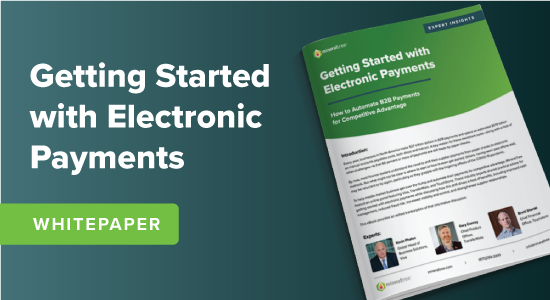Electronic payments (ePayments) have proven to be incredibly important to streamline accounts payable processes. But don’t take our word for it. In this blog, we’ll explore the top 7 advantages and benefits of electronic payment systems for your business and your suppliers. Let’s take a closer look.
Key takeaways
- Electronic payments, sometimes called ePayments, are digital monetary transactions between two parties.
- The most common types of electronic payments include card payments, bank transfer payments, virtual card payments, cross-border/FX payments.
- Some of the benefits your business will see from switching to an ePayment system include reduced transaction costs, secure ePayment transactions, saved time and resources.
What are electronic payments?
Electronic payments, or ePayments, are digital monetary transactions between two parties. There are a number of different factors that might inform a business’s decision to use or accept certain electronic payment types. ePayments offer a number of advantages and benefits, including cost and time savings, decreased payment processing errors, and reduced transaction costs.
What are the most common types of electronic payments?
At a fundamental level, ePayments can be boiled down into four categories:
Card Payments
Credit and debit cards are the most familiar type of electronic payment worldwide, though their popularity is decreasing among younger generations. Card payments remain attractive partially due to the rewards and rebates that they offer.
Bank Transfer Payments
The transfer of funds from one bank account to another can be done in a number of ways. ACH transfers are one type of bank transfer payment unique to the U.S. Similar to direct deposits, ACH transfer payments are deposited electronically into the recipient’s bank account.
Virtual Card Payments
A virtual card is a randomly-generated 16-digit number, or “token,” that can only be charged a single time and only for the specified amount. These protections that ensure a secure and impossible to decrypt payment are part of a process known as Payment Tokenization.
Cross-Border/FX Payments
FX payments allow businesses to send and receive money internationally via wire transfers, forward contracts, cross-currency transactions, and more. This is especially helpful to businesses working with overseas payment processing for their suppliers and customers.
Which types of businesses can benefit from electronic payments?
Electronic payments can benefit a variety of diverse industries including retail, healthcare, non-profit organizations, food and beverage, and education. No matter the industry, electronic payments can help businesses streamline payment processes, improve supplier relationships, reduce operational costs, enhance cash flow, as well as improve overall visibility into the accounts payable process.
How do electronic payments compare to traditional payment methods?
Electronic payments offer significant advantages when compared to traditional methods. Not only are ePayments faster, they are also more cost-effective, security, provide enhanced convenience, and can easily integrate with existing systems. These benefits make them a preferred choice for businesses looking to optimize their AP payment processes.
Which types of electronic payments are typically favored in B2B?
The preferred method for electronic payment is going to vary based on both the buyer and supplier; however, ACH payments continue to be the most common form of ePayment due to their low cost and speed, relative to checks. But ACH payments do have some potential drawbacks. For instance, ACH payments require businesses to manage their supplier’s bank account details, which increases their liability due to the potential risk of fraud or security breaches. Furthermore, ACH transfers are typically disconnected from the remittance email, leading to calls or emails from suppliers asking which invoice an ACH payment applies to.
Virtual cards, on the other hand, address both of these challenges. Virtual cards are the fastest form of payment, while only requiring an email address to send payments to vendors. Additionally, the email includes both the virtual card number and the remittance details, making it easy for suppliers to process and reconcile the payment.
Payments can also be made at a faster rate, which can improve supplier relationships. Considering that 58% of companies noted that supplier relationships became more strategically important over the last year, having an efficient AP process in place is a necessity in today’s marketplace.
What are the advantages of an electronic payment system?
ePayment systems introduce a host of new benefits and advantages for businesses, giving them the competitive advantage they need to stand out. Here are some of the benefits your business will see from switching to an ePayment system.
1. Reduced Transaction Costs
2. Secure ePayment Transactions
3. Saved Time and Resources
Let’s take a closer look.
1. Reduced transaction costs
Paper checks dominate business practices. Large businesses make half their payments via paper checks, while small businesses make 80 to 90% of their payments via paper checks!
Paper-based payments are a hassle for both businesses and suppliers. Though there are many disadvantages to using checks for B2B payments, collecting and processing paper checks is an extremely costly activity for most businesses and their suppliers, costing about $13 just to send an invoice and $5 to process a single check. Not only are paper-based payment methods expensive, but they are also slow. It can take upwards of two weeks for a check to clear.
By contrast, accepting a paperless process with electronic payments is relatively simple. Digital payment methods have the advantage of being faster, safer, easier to collect, and less expensive to the business. By incorporating electronic payment methods into your business’s account payable process, your AP department can realize saving on every invoice.
2. Secure ePayment transactions
Electronic payments are much more efficient and safe than their traditional, paper-based counterparts. ePayment methods and systems offer multiple ways of securing your payments, such as payment tokenization, encryption, SSL, and more.
Although digital solutions are not immune to hackers and security breaches, most electronic payment providers also have a host of data experts and engineers working to keep your payment information safe.
3. Saved time and resources
By adopting electronic payment methods, your business saves time for its teams, its customers, and its leadership. Processing supplier payments the traditional way takes a lot of time.
And we found that was just the case with one of our MineralTree clients. The House of Cheatham processes more than 750 invoices a month, averaging about 6 hours a week just to prepare payment runs. By switching to an electronic payment solution, they’re able to prepare their weekly payment run in just 5 minutes.
With a modern ePayment solution, much of the repetitive and manual tasks that plague accounts payable departments are automated, giving you and your accounts payable department more time to focus on important value-add areas of operations.
4. Speed of ePayments
Since electronic payments are made digitally, funds are transferred much faster relative to traditional payment methods like checks. ePayments allow users to make payments online at any time, from anywhere in the world, and also remove the need to go to banks.
Faster electronic payments, like virtual cards, empower businesses to improve security, visibility, and efficiency all while lowering costs and saving time on manual processes.
5. Complete visibility into electronic payment process
Electronic payments provide complete visibility and transparency throughout the entire payment process for both your business and your suppliers, thus improving the supplier relationship.
Transparency is an essential factor when it comes to supplier payments, electronic or otherwise. When you automate electronic payment processing, you gain greater insight into each step of the invoicing process. Automated processes provide greater control over outgoing cash flow compared to tedious, error-prone manual processes. This combination of process transparency, greater control over payments, and reduction of manual tasks means that it will be easier for your AP department to identify suspicious or fraudulent activity.
6. Improved supplier relationships with ePayments
Unlike paper checks that take time to write, process, and eventually post to your supplier’s bank account, electronic payments are fast, transparent, and secure. Paying suppliers on time and offering them complete visibility into the payment process, will naturally improve your relationships with suppliers. Beyond that, streamlining the payment process with electronic payments will reduce the number of late payments and therefore lower the number of supplier inquiries to your AP team. That’s a big time save considering 43% of AP teams spend over 6 hours a week answering vendor questions regarding payments. Improving and maintaining a strong supplier relationship is crucial, especially in the midst of an industry-wide supply chain disruption.
7. Electronic payments support remote and hybrid work environments
It has become evident that remote and hybrid work environments are here to stay for businesses around the world. And with remote invoice approvers and payment authorizers, traditional manual processes are no longer feasible, causing invoice and payment processing delays. This slows down the entire payment processing workflow and creates a disorganized structure for approving payments. Meanwhile, an electronic payment platform is entirely digital, allowing approvers to authorize payments from anywhere in the world, at any time. And not only that, invoices are coded and captured in a central system, organizing invoice processing and making it easy for authorizers to approve, pay, and execute payments to suppliers.
Switching to an electronic payments platform
The majority of businesses (71%) want to make more electronic payments, but the biggest barrier many businesses face is the willingness of suppliers to accept ePayments and the ability of their team members to contact and enroll vendors. It’s especially important to look for an AP automation solution that also offers supplier enablement services, like Vendor Self-Service Portals. Having supplier services removes the hassle of enrolling vendors and allows you to grow your electronic payments processes to reap more benefits.
There are several advantages to switching to an ePayment solution, but if you aren’t entirely convinced, then watch the webinar below or request a free demo to learn even more about the benefits of electronic payments for your business.
Advantages of electronic payments FAQs
What are ePayments?
E-payments, also spelt as ePayments, is short for electronic payments, and refers to the financial transactions conducted electronically.
Are electronic payments secure?
Electronic payments are far more secure than traditional, paper-based processes. ePayment methods provide secure transactions, including payment tokenization, encryption, SSL, and more.
How do electronic payments benefit businesses?
Electronic payments can benefit businesses by offering reduced transaction costs, secure ePayment transactions, saved time and resources, improved processing speeds, complete visibility, improved supplier relationships, and more.




